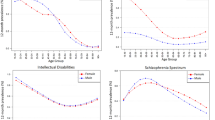Abstract.
Background:
Psychiatric epidemiology can further public health practice and inform mental health policy through the development of methodologies that provide rapid and cost efficient estimation of the prevalence of mental disorders at the local, regional, and population levels.
Objective:
The aim of this study was to illustrate an efficient method for the estimation of mental disorder prevalence in population groups where no direct prevalence data are available. This study demonstrated a new method to extrapolate prevalences from a national calibration survey to a target population where no observations are available and sociodemographic differences are prominent.
Method:
We restricted the ECA sample to full-time employed participants (~10,500) and used the total active duty U. S. Army population (~460,000) for illustration. Sociodemographic data for the Army came from the official military database (mid-year 2000). Our logistic regression projections represented an extension of sociodemographicdriven synthetic methods used among demographers. Outcomes were lifetime prevalences for 13 DIS/DSM disorders.
Results:
Compared to the ECA employed population, extrapolations to the Army revealed lower/similar estimates for nine of 13 DIS/DSM disorders. Projections were twice as high for alcohol abuse/dependence and antisocial personality, and one-third higher for social phobia and schizophrenia in the Army. Estimates compared favorably to one other military prevalence study, and to results derived using traditional standardization/adjustment methods based on the ECA sample weighted to the working general population.
Conclusions:
The synthetic estimation technique using ECA data to project lifetime prevalences for the U. S. Army generated sound estimates while illustrating an attractive method to extrapolate national data to demographically diverse communities seeking policy-relevant data.
Similar content being viewed by others
Author information
Authors and Affiliations
Corresponding author
Additional information
The ideas expressed in this article are the private views of the authors and do not reflect the official policy or position of the Department of the Army, the Department of Defense, the U. S. Government, or any of the institutional affiliations.
Rights and permissions
About this article
Cite this article
Messer, S.C., Liu, X., Hoge, C.W. et al. Projecting mental disorder prevalence from national surveys to populations-of-interest. Soc Psychiatry Psychiatr Epidemiol 39, 419–426 (2004). https://doi.org/10.1007/s00127-004-0757-1
Accepted:
Issue Date:
DOI: https://doi.org/10.1007/s00127-004-0757-1



